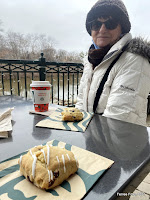Yesterday gave us a great
opportunity to visit the St. Louis Zoo. We had to go to St. Louis for another reason
anyway, and since the zoo requires reservations due to COVID, we felt safe in
their outside exhibits. This zoo has amazing animal exhibits, and it is free
(except the $10 parking fee). I t also has some nice landscape plants and displays.
 |
| Winterberry |
The first plant to greet us was a common
winterberry (
Ilex verticillata) in the parking lot. It’s bright clusters of red
berries covered the small shrubs, making quite an impressive display. This plant
is native to eastern North America. I’m not sure which cultivar this one was,
but the native plant grows 3-12 feet tall in an upright-rounded habit. This is
a holly plant, but unlike its relatives, it is a deciduous plant – dropping its
leaves each fall. Like its relatives, it is a dioecious plant and needs one
male plant for every 6-10 plants in order to produce berries.
 |
| Nandina at left, Bamboo at right |
Another red berried shrub attracting
attention was the heavenly bamboo (
Nandina domestica). Unfortunately, this is
not a native plant and is potentially invasive. This is not a true bamboo, though there
were giant cane bamboo plants (
Arundinaria gigantea) planted at the zoo.
A leatherleaf viburnum (Viburnum
rhytidophyllum) caught my eye in the bird garden, where signage discussed how
to garden to attract birds. This viburnum is an upright semi-evergreen shrub, reaching
6-10 feet tall.
Tucked under an arborvitae in the
bird garden was a plant that really surprised me. I never expected to see a tropical
looking plant in winter. Italiam arum (
Arum italicum) is an herbaceous perennial
shade plant hardy to zones 5-10. It prefers a moist soil in a shady area. The Missouri
Botanical Garden website says its “leaves emerge in autumn and are evergreen in
warm climates. However, in colder climates the leaves often die in winter,
resprout in spring, then go dormant in summer.
On our way out of the zoo, two
displays caught my eye. A container featured a blooming witchhazel surrounded
by pansy plants. See my blog on
witchhazels for
more information on this plant.
Also at the entrance was a 24-foot
tall giraffe topiary. Although not a live topiary, it was very impressive. I
believe it is part of their Christmas light displays. See the zoo’s YouTube on how they construct this
impressive giraffe.
Winter at the zoo was a different
experience that I really enjoyed. I really liked seeing the Bactrian camel,
Chinese goral, red panda, jaguar, Amur tiger, snow leopard, and grizzly bears (all pictured below). Of
course, the highlight of the St Louis Zoo for me is always the penguin exhibit.
I’ve been to many zoos across our nation and I think this penguin exhibit is
the best. It allows visitors to get up close and personal with the penguins and
puffins. This was especially true yesterday since there were so few zoo
visitors. We had a private viewing inside the penguin-puffin house – just us, four
types of penguins, two types of puffins, and a security guard.
Visiting the zoo during the COVID
pandemic felt very safe. The masks helped keep us warm, though it did take some
time to find a position where our glasses didn’t fog up so much.
We were able to take the masks off for a
coffee and scone break by a duck pond.
If you’ve never visited a zoo in the
winter, I highly recommend it. Although it was only 30 degrees outside, we were
bundled up warmly. In many ways it was more comfortable than former visits
there in the heat of summer.
 |
| Bactrian camel |
 |
| Chinese goral |
 |
| Jaguar |
 |
| Snow leopard |
 |
| Amur tiger |
 |
| Red Panda |
 |
| Grizzly bear |
 |
| King penguins |
 |
| Humboldt penguins |
















No comments:
Post a Comment